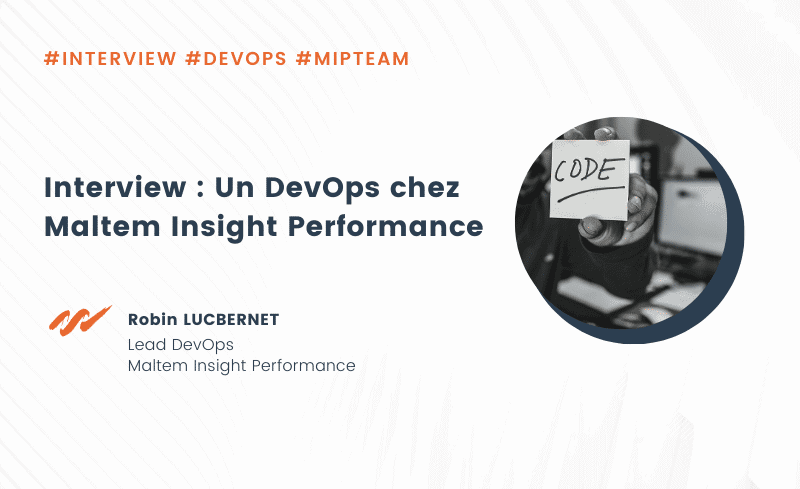
Interview: A DevOps at Maltem Insight Performance
DevOps is rapidly becoming a must for software companies such as Maltem Insight Performance. The missions of the latter have a common objective: to optimize humanly and technically the evolution phases of the platforms.
But what does the DevOps job actually involve? Interview with Robin Lucbernet, DevOps on the MIP Solution at Maltem Insight Performance.
 Robin, what is the value of having DevOps for software development?
Robin, what is the value of having DevOps for software development?
“DevOps can be likened to a mediator who operates between developers and infrastructure. I do not intervene strictly speaking on the functionalities of the application, but on the processes aimed at saving time for both teams. In the end, I am a developer who writes not for the product, but for the devs and the infrastructure!
- My mission: to automate as much as possible the validation process of the MIP Solution before integration.
- My goal is to help developers save time, limit their frustration, and speed up the integration of new features for the end customer.
- The tool: a continuous integration (CI) tunnel, composed of multiple tests to test the robustness of new features, and limit the risks of bugs during deployment…
At the center of this process, we find the Agile methodology, which is particularly important to me. By prioritizing customer requests, their needs, the market, and by ensuring good coordination between the development and infrastructure teams, DevOps continuously participates in improving the product.
It’s this balance between the human and the technical that I like the most: optimizing communication and automating tasks to achieve common goals more easily.”
How do you decide to develop this or that functionality?
“The priorities are given by the Product Manager (Product Owner) via the roadmap, thanks to a clever mix of customer demands, the market, and internal MCO needs (maintenance in operational conditions). With the infrastructure and the devs, we are there to provide technical support and identify the best choices.
For the MIP Solution, the issue is even more interesting: our say in the technical implementation is linked to the understanding of the code with its thousands of lines that are sometimes over 10 years old. This or that feature? The decision I have to make is mostly related to: How do I transition to today’s era?”
The MIP Solution has been in place for more than 10 years, how do you adapt to changes and new demands?
“After many discussions, we decided not to make a “Big Bang”: the idea of creating an ON/OFF button on a whole part of the software was not possible because we had to think about service continuity and the habits of our historical customers.
The wish is not to develop blindly on another software, hence the agile method. The ongoing construction of the MIP Solution is now based on a 2-step tunnel:
- The build : The solution is compiled and launched, and tests are performed to ensure that the application works properly with its new features.
- The post-build : The solution is packaged via Docker, a specialized software platform that facilitates deployment to customers.
With a substantial code history, we are trying to remodel everything following the roadmap. Agility is ultimately a real operational asset for our teams, who find both a framework and flexibility. On the one hand, the obligation to test its code, and on the other hand, the automation of processes. So we’re staying on schedule for the release of innovative new features, such as the API rollout!”
How often do you release new versions?
“With this method of testing the code, the results are easy to read: green light everything is good, red light we correct! The gain in reactivity being total, our developers do not waste any more time, and I thus maximize the quality of the upgrade for the new versions.
These releases are based on sprints, formerly every 6 months, and now reduced to a period of 2 weeks. The completion of this continuous integration even allows us to release a new version between the two-week timeframe, for example, for a very urgent customer request.”
Finally, as a DevOps, what are your goals for Maltem Insight Performance?
“Release on time features adapted to the market and customer demands, ensure that the MIP Solution is future-proof for optimal collaboration, and offers a fluid, intuitive, and… bug-free final navigation! ;)”